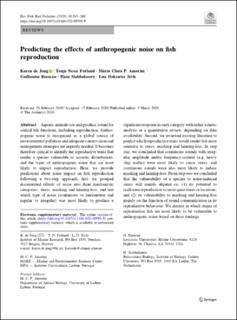| dc.description.abstract | Aquatic animals use and produce sound for critical life functions, including reproduction. Anthropogenic noise is recognized as a global source of environmental pollution and adequate conservation and management strategies are urgently needed. It becomes therefore critical to identify the reproductive traits that render a species vulnerable to acoustic disturbances, and the types of anthropogenic noise that are most likely to impact reproduction. Here, we provide predictions about noise impact on fish reproduction following a two-step approach: first, we grouped documented effects of noise into three mechanistic categories: stress, masking and hearing-loss, and test which type of noise (continuous vs intermittent and regular vs irregular) was most likely to produce a significant response in each category with either a meta-analysis or a quantitative review, depending on data availability. Second, we reviewed existing literature to predict which reproductive traits would render fish most sensitive to stress, masking and hearing-loss. In step one, we concluded that continuous sounds with irregular amplitude and/or frequency-content (e.g. heavy ship traffic) were most likely to cause stress, and continuous sounds were also most likely to induce masking and hearing-loss. From step two we concluded that the vulnerability of a species to noise-induced stress will mainly depend on: (1) its potential to reallocate reproduction to more quiet times or locations, and (2) its vulnerability to masking and hearing-loss mainly on the function of sound communication in its reproductive behaviour. We discuss in which stages of reproduction fish are most likely to be vulnerable to anthropogenic noise based on these findings. | en_US |
